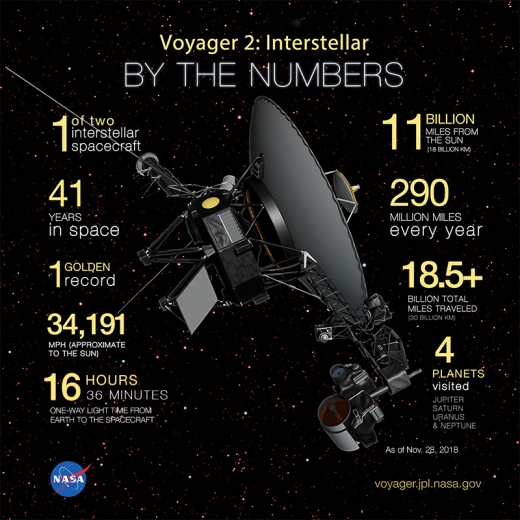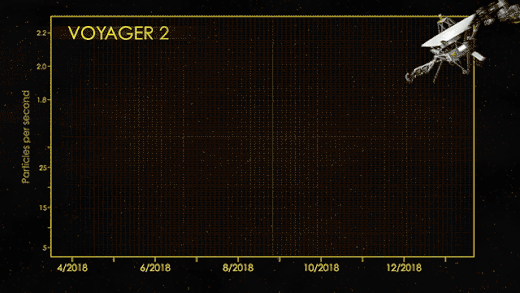Voyager 2 has now gone interstellar, making it not only NASA’s single longest-running mission but one of only two spacecraft that have crossed over from the heliosphere to true interstellar space, what scientists call the Local Interstellar Medium (LISM). On that note, it’s interesting to put the Solar System in context. Depending on how you define the term, the Solar System takes in a great deal of interstellar space. Many astronomers put its outer edge at the outer Oort Cloud, perhaps 100,000 AU away, and both Voyagers have yet to reach the inner Oort.
At an estimated 1,000 AU, the inner boundary of the Oort Cloud is where the vast cometary cloud around our star becomes apparent, housing in its entirety trillions of comets and extending about 40 percent of the way to the Alpha Centauri stars. The Voyagers will keep going, of course, and will reach the inner Oort in perhaps 300 years, though without working instrumentation. The steady diminishment of power from the crafts’ radioisotope thermal generators (about 4 watts per year) means we have ten years or less to power instruments.
What a splendid run this has been, and we’re still performing good science.

Image: Artist’s concept of Voyager 2 with 9 facts listed around it. Credit: NASA.
Speaking of instruments, it is the robust health of one in particular that has made the Voyager 2 crossover so apparent. Both Voyagers carry a Plasma Science Experiment (PLS), but the one on Voyager 1 stopped working in 1980. But Voyager 2’s PLS told the tale: Measuring the plasma outflow from the Sun — commonly called the solar wind — Voyager 2 could chart the speed, density, temperature, pressure and flux of the plasma. The steep decline in the speed of the solar wind particles on November 5, and the fact that since that time, the PLS has seen no solar wind flow around Voyager 2, leaves little doubt the craft has departed the heliosphere.
“Working on Voyager makes me feel like an explorer, because everything we’re seeing is new,” said John Richardson, principal investigator for the PLS instrument and a principal research scientist at the Massachusetts Institute of Technology in Cambridge. “Even though Voyager 1 crossed the heliopause in 2012, it did so at a different place and a different time, and without the PLS data. So we’re still seeing things that no one has seen before.”
Cameras aboard the Voyagers were turned off long ago to conserve power, but beside the PLS, three other instruments continue to function: The low-energy charged particle instrument, the magnetometer, and the cosmic ray subsystem. All of these show data consistent with Voyager 2’s having crossed the heliopause. We can now compare results from both Voyagers as we investigate the interstellar medium, learning how the heliosphere itself interacts with the plasma flow JPL calls the ‘interstellar wind.’

Image: Animated gif showing the plasma data. Credit: NASA/JPL-Caltech.
Bear in mind we also have the Interstellar Boundary Explorer (IBEX) in operation, making observations of the boundary from within the heliosphere. Also in the cards is the Interstellar Mapping and Acceleration Probe (IMAP), which will operate at the L1 Lagrange point about 1.5 million kilometers from Earth to monitor solar wind interactions at the edge of the heliopause by collecting and analyzing particles that make it through the boundary from the LISM. The latter mission is scheduled for launch in 2024, and I’ll have more to say about it soon.
Long-haul missions to deep space demand payloads that can function for decades and perhaps centuries, a fact that has concerned mission designers contemplating component lifetimes in this harsh environment. It’s heartening to think of the two Voyagers, then, for both were built to last five years, enough to make their flybys of Jupiter and Saturn. Uploaded programming helped with the Uranus and Neptune flybys, the latter occurring 12 years after launch. Who would have thought that 41 years into the mission we would still be taking data?
We’re learning numerous lessons about spacecraft longevity by their example, and can contemplate future missions specifically built for interstellar medium exploration. The challenges of getting to, say, the 550 AU gravity lens of the Sun are immense, but if spacecraft built so long ago can leave the heliosphere, next-generation missions are well within our capability. What kind of interstellar precursor will follow the Voyagers and New Horizons out toward the Oort?



11 Billion miles is less understandable that the equivalent in AU, 118.336.
Amazing that the sun’s wind has enough umph to push out more than 118 AU against the combined stellar winds of interstellar space.
Let us not forget that at least three more space vessels will be following Voyager 1 and 2 into the interstellar realm as defined in this article, Pioneer 10 and 11 and New Horizons, along with most of their final rocket stages.
Here are some Web sites on the Interstellar Mapping and Acceleration Probe (IMAP):
https://imap.princeton.edu/
http://lasp.colorado.edu/home/missions-projects/quick-facts-imap/
What has been going on in terms of progress regarding the Innovative Interstellar Explorer?
https://centauri-dreams.org/2012/01/09/innovative-interstellar-explorer-a-response-to-questions/
https://centauri-dreams.org/2011/12/20/update-on-innovative-interstellar-explorer/
Quite a rush of events recently, enough to keep Paul G. very busy. Thank you for keeping us up-to-date!
Alnos expecting some alien artifact to be found: even the equivalent of a discarded beer can would be paradigm-shattering.
Yip those alien space monkeys from the Toopist system are litter bugs alright.
This being 120 AU out, the task of getting a gravscope to the solar focus, more than 550 AU out, indeed looks daunting. Beamers or fusion seem to be the preferred method?
Since we have neither beamers nor fusion propulsion, and probably will not for decades, how about a nuclear fission engine? We have those, they work, and they can be done now.
Some time in late November there was an interesting event, i think. The GIF of the plasma data appears to show a spike in heliospheric hits and a corresponding dip in cosmic ray intensity. Did the sun have a cme that blew out the cosmic rays for a short time back then?
The spike and dip were obviously the cosmic ray shadow and engine radiation of an inspection craft that popped by. I’m trying to figure out what 34,191MPH to the sun means. Could that be the total acceleration of an object starting at rest out there and falling to the sun? Or what???
That’s simply the speed with respect to a reference frame defined by the sun at rest. Just like a satellite in low Earth orbit moves at around 17,500 mph with respect to the center of the planet.
Thanks Robert. It could have been stated better because it sounded like it was meant to be a distance.
Artifacts In Space
Posted on 2018-12-13 by Marc Kaufman
All of a sudden, we have spacecraft and objects both coming into our solar system and leaving for interstellar space. This is highly unusual, and very intriguing.
The departing spacecraft is Voyager 2, which launched in 1977 and has traveled spaceward some 11 billion miles. It has now officially left the heliosphere, the protective bubble of particles and magnetic fields created by the sun. In this it follows Voyager I – which left our solar system in 2012 — and managers of the two craft have reason to think they can travel until they cross the half-century mark.
This is taking place the same time that scientists are puzzling over the nature of a cigar-shaped object that flew into the solar system from interstellar space last year.
Nobody knows what the object – called Oumuamua, Hawaiian for “first messenger,” or “scout” – really is. The more likely possibilities of it being a comet or an solar system asteroid have been found to be inconsistent with some observed properties of the visitor, and this has led some senior scientists to even hypothesize that it just might be an alien probe.
Full article here:
http://www.manyworlds.space/index.php/2018/12/13/artifacts-in-space/
To quote:
At the on-going American Geophysical Union annual meeting, NASA project manager Suzanne Dodd said she believed that Voyager 2 can keep functioning for 5 to 10 more years in this new region of space, though not with all its instruments operating.
The greatest concerns about keeping the probes operating, she said, involve power and temperature. The nuclear-powered Voyager 2 loses about 4 watts of power a year, and mission scientists have to shut off systems to keep instruments operating.
Voyager 2 is very cold — about 3.6 degrees Celsius and close to the freezing point of hydrazine — leading to concerns about the probe’s thruster that uses this fuel. Dodd says she’s set a personal goal of keeping at least one of the Voyagers going until 2027, making it a 50-year mission.
Aging Voyager 1 spacecraft undermines idea that dark matter is tiny black holes
By Adrian Cho
Jan. 9, 2019 , 2:25 PM
Humanity’s most far-flung spacecraft, NASA’s 41-year-old Voyager 1, has poked a hole in a long-shot theory of dark matter. Some theorists have argued that the mysterious, unseen stuff, which makes up 85% of the universe’s matter, could consist of countless black holes lingering from the big bang. But Voyager 1, which launched in 1977 and slipped out of the solar system 6 years ago, sees no signs of such hordes, a pair of theoretical physicists reports. The data don’t kill the idea that dark matter is black holes entirely, however, as Voyager 1 can detect only tiny black holes.
“I never thought we’d be able to contribute in any way to studying dark matter,” says Alan Cummings, a space scientist at the California Institute of Technology in Pasadena who has worked on Voyager 1 since 1973 and who was not involved in the analysis. “That’s great!”
Full article here:
https://www.sciencemag.org/news/2019/01/aging-voyager-1-spacecraft-undermines-idea-dark-matter-tiny-black-holes
To quote:
Tiny black holes weighing 10 billion metric tons should be hot enough to radiate electrons and positrons. Earth-bound detectors would not be able to spot those low-energy particles, as they would be deflected by the sun’s magnetic field. But Voyager 1 should be able to spot them from its position outside the sun’s magnetic bubble, the heliosphere.
In fact, since it exited the heliosphere in 2012, Voyager 1 has measured a small, consistent flux of positrons and electrons. But even if they all come from tiny black holes, there wouldn’t be enough black holes to account for more than 1% of the Milky Way’s dark matter, Boudaud and Cirelli calculate. Cummings says the energy spectrum of the particles suggests they all come from more mundane sources such as the remnants of supernova explosions.
The new work comes close to ruling out the lowest mass primordial black holes as dark matter, Carr says, although he adds that he has always favored the scenario in which the black holes weigh several solar masses. “This [low] mass window has never been my favorite,” he says. “It doesn’t personally bother me if the constraints now rule it out.”
Voyager 1 can’t search for the higher mass primordial black holes. They would be so heavy and cold that they could not radiate massive particles such as electrons and positrons. Instead, they would only shine an exceedingly feeble and likely undetectable light. So, for the moment, the idea of black hole dark matter lives on.
The Vinyl Frontier: The Story of the Voyager Golden Record
by Jonathan Scott
https://thejonoscott.com/